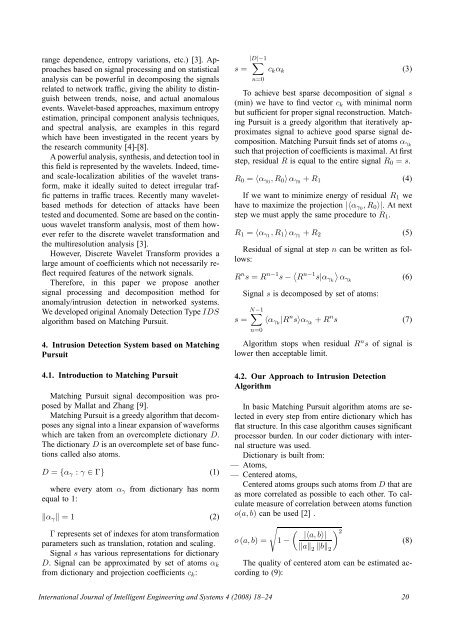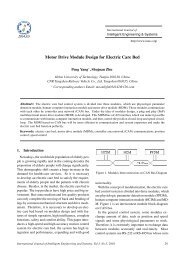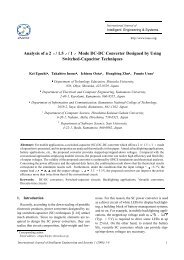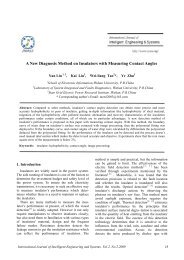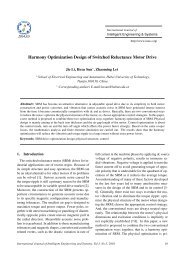IJIES-2008 VOLUME 1 ISSUE 4 - Index of
IJIES-2008 VOLUME 1 ISSUE 4 - Index of
IJIES-2008 VOLUME 1 ISSUE 4 - Index of
- No tags were found...
Create successful ePaper yourself
Turn your PDF publications into a flip-book with our unique Google optimized e-Paper software.
ange dependence, entropy variations, etc.) [3]. Approachesbased on signal processing and on statisticalanalysis can be powerful in decomposing the signalsrelated to network traffic, giving the ability to distinguishbetween trends, noise, and actual anomalousevents. Wavelet-based approaches, maximum entropyestimation, principal component analysis techniques,and spectral analysis, are examples in this regardwhich have been investigated in the recent years bythe research community [4]-[8].A powerful analysis, synthesis, and detection tool inthis field is represented by the wavelets. Indeed, timeandscale-localization abilities <strong>of</strong> the wavelet transform,make it ideally suited to detect irregular trafficpatterns in traffic traces. Recently many waveletbasedmethods for detection <strong>of</strong> attacks have beentested and documented. Some are based on the continuouswavelet transform analysis, most <strong>of</strong> them howeverrefer to the discrete wavelet transformation andthe multiresolution analysis [3].However, Discrete Wavelet Transform provides alarge amount <strong>of</strong> coefficients which not necessarily reflectrequired features <strong>of</strong> the network signals.Therefore, in this paper we propose anothersignal processing and decomposition method foranomaly/intrusion detection in networked systems.We developed original Anomaly Detection Type IDSalgorithm based on Matching Pursuit.4. Intrusion Detection System based on MatchingPursuit4.1. Introduction to Matching PursuitMatching Pursuit signal decomposition was proposedby Mallat and Zhang [9].Matching Pursuit is a greedy algorithm that decomposesany signal into a linear expansion <strong>of</strong> waveformswhich are taken from an overcomplete dictionary D.The dictionary D is an overcomplete set <strong>of</strong> base functionscalled also atoms.D = {α γ : γ ∈ Γ} (1)where every atom α γ from dictionary has normequal to 1:‖α γ ‖ = 1 (2)Γ represents set <strong>of</strong> indexes for atom transformationparameters such as translation, rotation and scaling.Signal s has various representations for dictionaryD. Signal can be approximated by set <strong>of</strong> atoms α kfrom dictionary and projection coefficients c k :s =|D|−1∑n=0c k α k (3)To achieve best sparse decomposition <strong>of</strong> signal s(min) we have to find vector c k with minimal normbut sufficient for proper signal reconstruction. MatchingPursuit is a greedy algorithm that iteratively approximatessignal to achieve good sparse signal decomposition.Matching Pursuit finds set <strong>of</strong> atoms α γksuch that projection <strong>of</strong> coefficients is maximal. At firststep, residual R is equal to the entire signal R 0 = s.R 0 = 〈α γ0 ,R 0 〉α γ0 + R 1 (4)If we want to minimize energy <strong>of</strong> residual R 1 wehave to maximize the projection |〈α γ0 ,R 0 〉|. At nextstep we must apply the same procedure to R 1 .R 1 = 〈α γ1 ,R 1 〉α γ1 + R 2 (5)Residual <strong>of</strong> signal at step n can be written as follows:R n s = R n−1 s − 〈 R n−1 s|α γk〉αγk (6)s =Signal s is decomposed by set <strong>of</strong> atoms:N−1∑n=0〈α γk |R n s〉α γk + R n s (7)Algorithm stops when residual R n s <strong>of</strong> signal islower then acceptable limit.4.2. Our Approach to Intrusion DetectionAlgorithmIn basic Matching Pursuit algorithm atoms are selectedin every step from entire dictionary which hasflat structure. In this case algorithm causes significantprocessor burden. In our coder dictionary with internalstructure was used.Dictionary is built from:— Atoms,— Centered atoms,Centered atoms groups such atoms from D that areas more correlated as possible to each other. To calculatemeasure <strong>of</strong> correlation between atoms functiono(a,b) can be used [2] .o(a,b) =√1 −( |〈a,b〉|‖a‖ 2‖b‖ 2) 2(8)The quality <strong>of</strong> centered atom can be estimated accordingto (9):International Journal <strong>of</strong> Intelligent Engineering and Systems 4 (<strong>2008</strong>) 18–24 20


